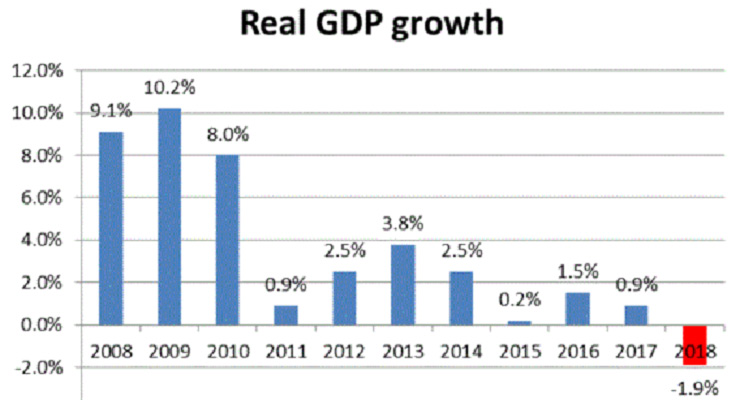Recession first
started in 2018
Inflation increased to 5.5 percent
| Share |
|

|
|

|
|
|
|
The gross domestic product (GDP) at constant prices dropped by 1.9 percent in 2018 driven by a decline in household consumption and in the construction and trade sectors, according to the National Accounts report for 2018 released by the Central Administration of Statistics (CAS).
“This reflects the tough conditions experienced by the Lebanese economy in 2018, driving real growth into negative territory,” the CAS said in the report.
The results are in contrast to estimations of real GDP growth at 0.2 percent in 2018 by the International Monetary Fund (IMF) and the World Bank.

Source: Central Administration of Statistics
GDP at current market prices for 2018 is estimated by CAS at LL82.9 trillion ($55 billion).
CAS said that the economy became close to a stagflation status in 2018. Stagflation consists of recession and inflation occurring at the same time. Inflation increased to 5.5 percent in 2018 from 2.9 percent in the previous year.
A slump in household consumption, which represents 91 percent of GDP, contributed 1.2 percent to the negative GDP growth. “In the past, increases in household consumption led real GDP growth,” according to the report.
On the supply side, the wholesale and retail trade sectors declined by seven percent triggering a 0.9 percent drop in the GDP. The construction sector weakened by ten percent and caused a 0.4 percent decrease in the GDP. “Education posted an unusual decline of five percent,” according to the report.
The sectors that have witnessed growth in 2018 include beverages, tobacco, personal and community services, electricity, water supply, and waste management.
Reported by Shikrallah Nakhoul
Date Posted: Jan 14, 2020
| Share |
|

|
|

|
|
|
|